Its other merits, or lack thereof, aside, EA Sports is doing something very interesting and probably very right in its console NASCAR series. It's changing the way we look at racing. Slowly and deliberately, it's transforming competitive driving from a lonely solo sport to one that brims with interaction. It's turning us from mere drivers into owners and managers, off-track decision-makers and career-seekers. Certainly EA isn't the first to move in this direction; but with this year's game, that sort of teamwork is clearly now at the forefront of the experience.
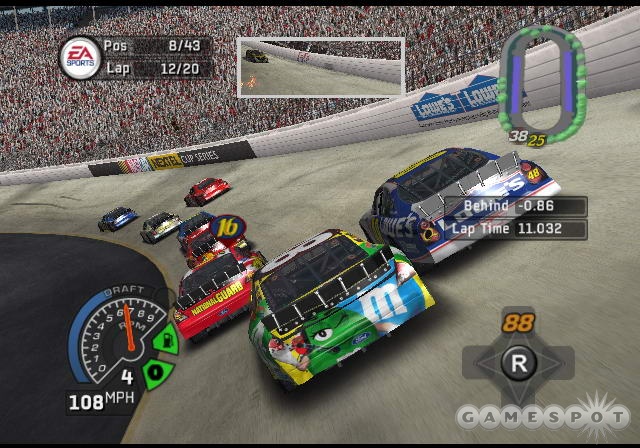
In NASCAR 06: Total Team Control, EA ups the peripheral intrigue from last year's NASCAR 2005: Chase for the Cup by throwing us into a world where drivers don't race merely for their own personal glory, but that of their entire team. They communicate constantly with their allies; they swap cars with teammates in the midst of the action; and they ultimately have a chance to buy their own team and govern darn near every facet of it. The game's vehicular physics and graphics have not been significantly altered--and that may be a detraction for some--but anyone hankering for a refreshing new perspective into virtual racing will find NASCAR 06 an attractive proposition.
As its name suggests, NASCAR 06 sets its sights squarely on North America's preeminent and currently most popular racing "league," the National Association for Stock Car Auto Racing. It doesn't quite feature all the drivers and vehicles in the four series it showcases (the Whelan Modified Tour, NASCAR National Series, Craftsman Truck Series, and the granddaddy Nextel Cup), but it comes close enough for all but ultrahardcore fans. It packs a couple dozen real life tracks (now including Pocono), many real-world sponsors, a ton of racing modes, and oodles of real and imaginary teams. In this way, it's very similar to the other top-level, licensed NASCAR games we've seen in recent years.
But it's what isn't similar that matters most. Arguably, the most important (and certainly the most publicized) innovation in the latest NASCAR is its concept of "squad-based racing." And the truth is that this whole team thing is pretty cool. Indeed, many indoctrinated drivers may recognize the same thing we did--that they'd never given serious thought before to working as part of a team. Isn't this whole racing thing all about personal glory? Well, no--not now, it isn't.
In NASCAR 06, you can't simply go about your business, thinking everyone else is the enemy. This will undoubtedly come as nothing short of a revelation to many longtime virtual drivers, who've likely spent years perfecting the art of nudging and bumping and imparting glancing blows to nearby cars with the sole intention of bettering their own position. You're certainly welcome to do that in NASCAR 06, but you'd just better take care with whom you do it. If you do it to a nonteammate, he just might build a quick grudge and become your sworn enemy, spurred ever onward by thoughts of malice and car-thumping revenge. That much hasn't changed. But if you bop a member of your own team into a wall or into a spin, he'll not only get a hate on for you, but may also finish the race in a less advantageous position. And that, in turn, has negative repercussions for your team ranking, your team status, and ultimately, you.
But there's far more to this team concept than steering clear of your buddies. The game also lets you communicate and pseudo-interact with a whole host of allies. First and foremost are your driving colleagues, with whom you can bark orders such as "hold position," "work with me," and "drop back." The particularly nifty thing is that they actually respond in a realistic fashion. For instance, you won't see your comrade suddenly apply the brakes as if he's getting ready to park when you ask him to "drop back." Instead, he'll carefully pick his spot and gradually comply. Alternately, if he's caught up in a fender-to-fender duel with another driver and you ask that he "move over" to clear a path for your car, he might decide that's not something he should do at the moment.
When used correctly, these orders can have a perceptible impact on the results and your team's progress. Indeed, one of the most effective things you can do is set up two- or three-car drafts to theoretically blow by the opposition. Conversely, one of the most ineffective things you can do is worry about a bunch of orders in short races, where there really isn't enough time to fully take advantage of them. In the end, you'll see that teammate commands work best when you've selected medium or, preferably, long race distances, where you have enough time to fully implement and perfect your pack mentality.
Undoubtedly, the most fascinating command you can issue is "swap cars." Say you've moved into a good position on the track but your teammate is mired near the back of the pack. You merely issue this wonderful instruction and you're immediately--and quite literally--catapulted into his car, while he moves into yours. The visual effect of flying through space into your compatriot's machine is a thrilling ride all by itself, but the possibilities it creates are even more fun. Take over your buddy's ride and steer him to a better finish, and you'll improve your team's ranking and prestige. Of course, you'd better hope you can do a better job than he did; otherwise, it's all for naught.
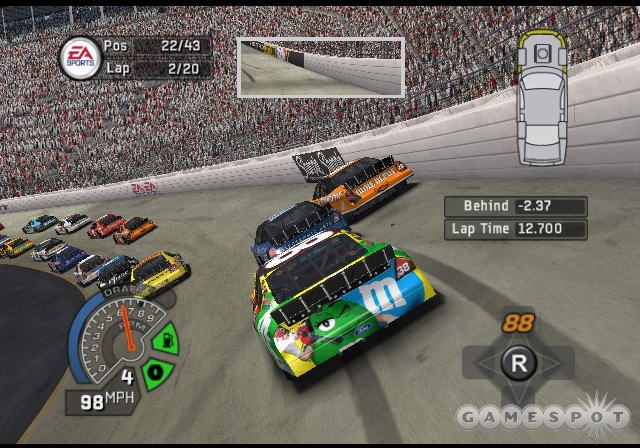
But while interteam communication is certainly an innovative wrinkle, it's the manner by which you can do it that's especially exciting. Yes, the game accepts button presses for each of its commands, but adopting that style severely restricts the number of commands at your disposal. Moreover, you're forced to hunt for buttons when you should be driving. A far, far better way is available to those lucky folks with Xbox or PS2 headsets. If that's you, you simply speak your peace into the mic and get on with your racing.
When you do connect your headset, the game will automatically recognize it. Through it, you'll immediately hear voices of your crew chief and what seems like an entire panel of advisors and spotters. Other sounds, effects, and music will continue to originate from your television or usual sound system. All this verbal advice and information really adds to the sense of being there.
The game recognizes approximately 40 individual phrases. These run the gamut from teammate orders to pit strategy modifications such as "do not repair damage" and update queries like "Who is the leader?" and "Where are my teammates?" You can even perform basic interface adjustments such as switching off the mirrors or the heads-up display or changing camera perspectives. Sadly, you cannot "teach" the game new commands.
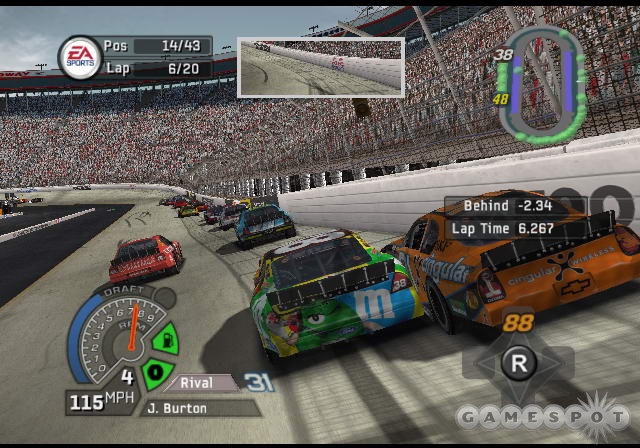
Of far greater importance is the unfortunate fact that NASCAR 06's voice-recognition coding is far from perfect. We typically found that approximately one out of every half-dozen of the commands we issued or questions we asked was misinterpreted. That's not so bad if you're merely asking that the music be switched off. But it becomes downright annoying, and certainly detrimental, if you suddenly hear your pit boss confirming your request for half a tank of gas when you made no such request. And should you find yourself mistakenly being transported to a teammate's car when all you wanted to do was switch on the HUD, well, you can be forgiven for feeling a mite nasty.
Having said that, we found that some of our miscommunication was a direct result of improperly speaking the required phrase. If, for example, we said "block" rather than "block for me," the game would misinterpret it to mean "swap," "HUD," or some other similar order or request. It's a very good thing, then, that the game offers visual and aural verification of your input. If you say "pit now" and the game recognizes it, you'll see "pit now" on the screen and hear some form of verification. If it failed to understand you, you'll hear an incorrect response and see "unrecognized" displayed on the screen. But by that time--depending on the nature of your command--it may be too late. Furthermore, even with the voice-sensitivity setting cranked down, it will "hear" phrases you didn't even say and then initiate incorrect actions or issue corresponding but incorrect snappy comebacks. Receiving a reprimand for uttering profanity is admittedly cool, but receiving a monetary fine when you've said nothing at all isn't nearly as cool. Being accused and found guilty of something you didn't even do is just wrong. Miscommunication aside, there's little doubt that this whole team-based idea opens up the potential for some...er...questionable techniques. Say, for example, you're sent for a spin in the last few laps of a race and now find yourself situated at the back of the pack, far behind your next-closest opponent. In a typical racing game, you'd simply finish up the event as best you can. But in NASCAR 06, perhaps you might want to stop your car for a moment, turn it around, and cause a little trouble for your nonteammates when next they come around the track. Say, a little nudge into the wall for the leader.
Good idea? Maybe. But you'll want to ensure you don't collect your own guys along the way. That's a tough proposition, because those little identification balloons that appear above the cars of your teammates and angry rivals disappear when the game perceives those cars to be behind you. You can't tell who's who in your rearview mirror, and you definitely can't distinguish friend from foe when you're looking at a swarm of cars advancing upon you.
Perhaps the real question here is whether you want to become a hero or a villain. Once again, EA's version of NASCAR has a certain pro-wrestling feel to it in this respect, though that's not necessarily a bad thing. Indeed, it's just one more way the series goes beyond the classic "get in and drive" format. The intimidator move, wherein you signal that you want to bully a given driver and hopefully throw him off his game, is again available, as is the far more sociable "share draft." Our advice? That depends which of the game's multitude of modes and special events you're currently playing.
Certainly, becoming a full-fledged villain has its advantages. When you're a true bad guy, you gather a big, fickle fan base and prestige points in much the same way you do if you're a good guy. But if you're in the midst of the game's central mode, fight to the top, you'd best quell that burning desire to aggressively push and punt cars out of the way. After all, wins and good finishes are far more imperative than ineffectual prestige, and there's nothing more convincing than a field rife with balloon-sporting haters, each harboring a desire to either block the heck out of you or bash you to smithereens, to ruin your drive to be the very best. Even the odd verbal admission of guilt during your race or a postevent apology via your text-based cell phone conversations with default agent Ace Moneymaker won't be enough to stop the bleeding, once half the field is out to get you. Furthermore, you'll undoubtedly accrue quite a few villain points anyway, through completely accidental maneuvers--so you probably don't need to create more angry drivers purposely.
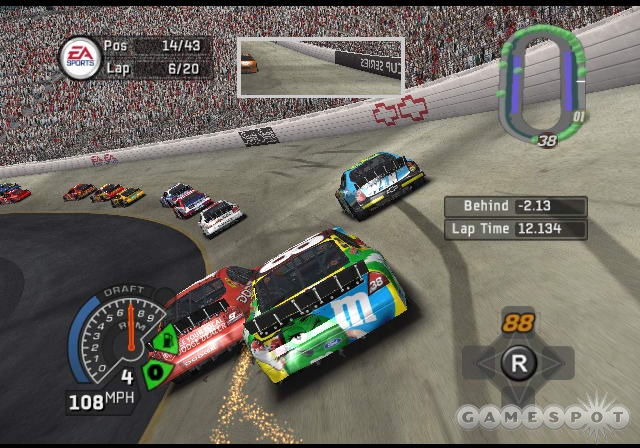
Is the "world" surrounding your racing believable? Initially. Superficially. Your agent, Mr. Moneymaker, calls to advise you that a competing driver is seriously steamed. Well, he should be. You've just backtracked and smashed him to bits until nothing was left but a steaming, molten hunk of metal. Yet if you offer a simple apology, everything between you may well be instantly hunky dory. Would that happen in real life? No chance.
But there's more to your off-track duties than dealing with an occasional fuming driver. In NASCAR 06, you'll not only field offers from other teams, and eventually, other series, but you'll also have a chance to straight-out buy a team and run it yourself, rather than meekly waiting for contracts to come to you. This is just one more very large and comprehensive new wrinkle--one more way you can attack the game.
Apart from NASCAR 06's questionable graphics (we'll get to that in a moment), the feel behind the wheel is pretty darned good. We'll call it approachable yet challenging. Certainly this is not a game where you can expect to use walls and other bits of scenery to keep you pointed in the right direction and moving quickly, even if you've activated driver's aids such as nonwearing tires and the ideal racing line (which, incidentally, changes color in the corners if your speed is too fast).
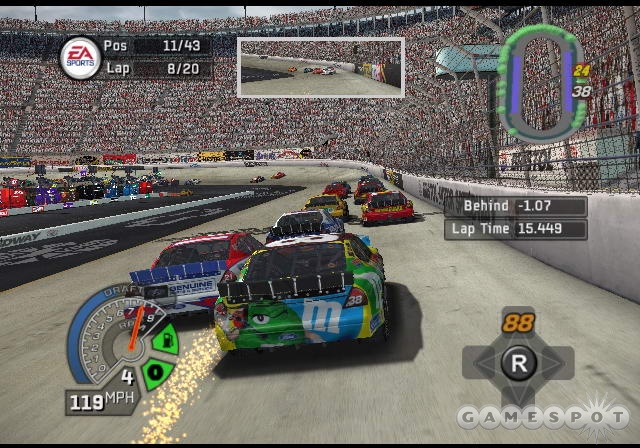
It is also not a game in which a gamepad-equipped driver stands much of a chance. We tried hard--really hard--to realize some level of success without our wheel, but we were never able to do very well. Yet the moment we moved to a wheel/pedal setup was also the moment we found satisfaction. So while a headset is a strongly suggested piece of gear, a wheel is almost mandatory. This is a good thing, of course, because it proves NASCAR 06 sports a somewhat complex physics model that's several notches up from arcade-type pretenders. However, it does not feel much removed from the physics of last year's already agreeable model.
Of special note is the importance of drafting. This is nothing new to the series, but now, with friendly tactics such as shared drafting and an entire four-man team with which to perfect the art, this element has never been more critical. Losing the train by brushing up against the wall or getting a little wonky coming out of a turn is always a bad state of affairs, no matter what track you're currently running.
As for your artificial competition, they're nothing short of believable. Their aggression level is varying and dynamic. Their propensity for crashing is ideal--not so high that you'll partake in a demolition derby, but not so limited that you'll grow weary of their unending perfection. And though they do try to steer clear of your human errors, they aren't magically immune to you, either. Fortunately, your own car's reaction to instances of mild contact is superior. Brushing into an opponent through a corner doesn't throw you into a spin, but nor does it leave you feeling untouched. Needless to say, you're often forced to deal with a slightly squirrelly automobile.
Visually, NASCAR 06 delivers bigger, better car damage and a full slate of vehicular aerobatics. It also features a wonderful rendition of postaccident smoke that temporarily obliterates the track in front of you and compels you to sweat bullets for fear of what lies on the other side. Otherwise, both the Xbox and PS2 versions are beginning to show their age. Indeed, they've seemingly pushed the graphic capabilities of the current Xbox and PS2 systems to their outer limits.
One thing is clear--the design team would have been well advised to spend less time incorporating peripheral visual effects and more time developing a cleaner, freer-flowing on-track experience. In a word, NASCAR 06 looks rough. It feels rough too, exhibiting frame rate problems when the action is heavy and you're running with a full HUD and mirrors. But while the Xbox iteration is still quite passable, the PS2 environment is sometimes so jumpy and so aliased that your driving can't help but occasionally suffer.
A believable sense of speed is somewhat lacking out of the box. But if you pull up the settings, then the display menu when you're in the car, and hike up the speed (FOV) slider, you'll definitely increase the sense of motion. This comes, of course, at the expense of the already suspect frame rate, which is definitely not a good thing when you're driving among a huge field of cars and the console's muscle is already being taxed.
Audio is a different story. With a constant flow of banter cascading through your headset, you'll rarely feel bored out there. The game also does a credible job with sound effects, giving you enough audible information to effectively gauge the moment-to-moment condition of your car and its tires. By default, some sounds seem to muddle with others, but the audio option menu takes care of that.
As usual, EA Sports' documentation is woefully inadequate. Why, for example, it hasn't enclosed a list of the voice commands--thus forcing you to head to the EA Sports site for a printable PDF file--is a question for the ages. As for garage setup advice, you're pretty much on your own. That is indeed unfortunate, particularly for new players, because a good setup is acutely critical to a good performance. Considering that even ultrapurist NASCAR sim designers like Papyrus saw fit to include various default setups and oodles of printed advice for each circuit with its products, you have to wonder why EA couldn't have done the same.
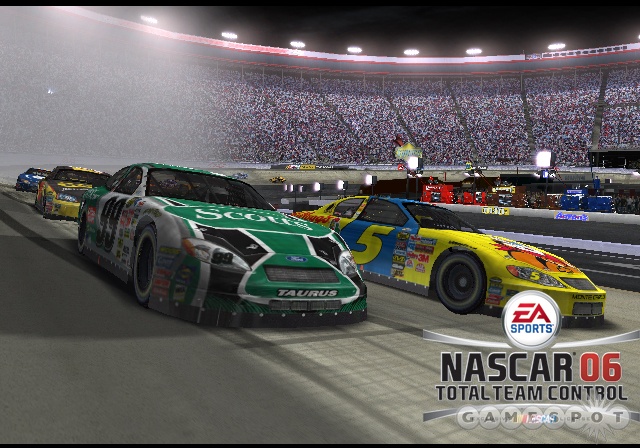
Online NASCAR 06 is, for want of a better description, adequate. Yes, both versions deliver enough online racing modes to keep most players driving for some time to come, but the four-player restriction of previous installments remains unchanged. Ah, to be able to compete with a full field--or even a half field--of real live humans would add greatly to the replay value. One other annoyance: You're booted from your chosen track immediately after an online race, so you can't immediately reorganize a grudge match or converse with your (often profane) peers.
If EA hadn't instituted the new team-based component and associated voice support, NASCAR 06 would not be a recommended follow-up to last year's effort. But it did, and it did so in a generally successful manner. Voice recognition problems aside, this new element appreciably alters the end product. If the team concept and voice command features appeal to you, you know what you must do. If not, stick to NASCAR 2005.